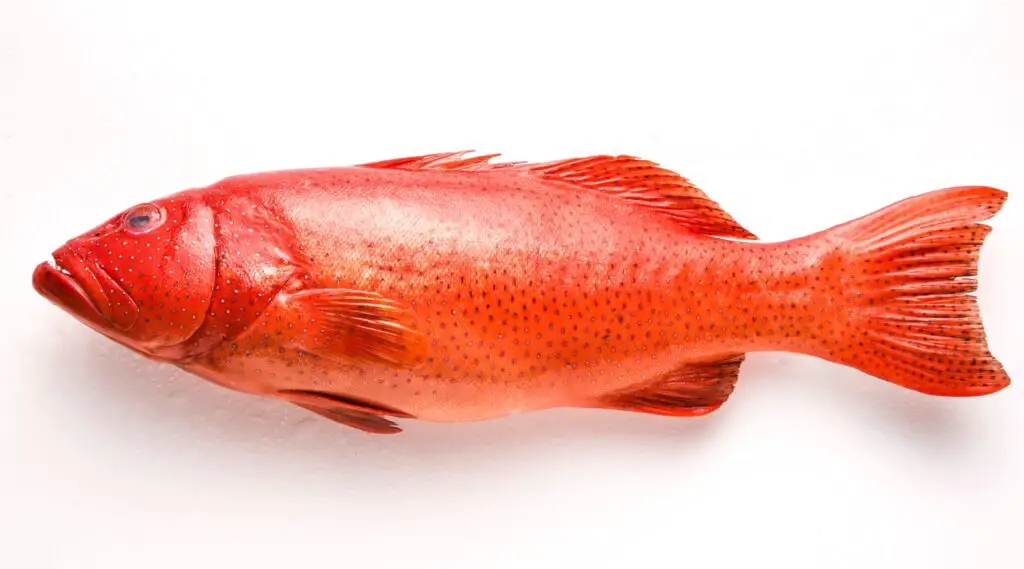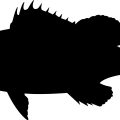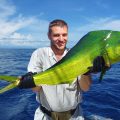If you are interested in the grouper species, you must have heard about the Red Grouper. A member of the family Serranidae, which also contains the anthias and sea basses, the red grouper is a ray-finned fish found in marine environments. The western Atlantic Ocean is where you’ll find it.
Red Grouper changes to males at sexual maturity, between 7 and 14 years old. When the spawning season approaches, male and females release sperm and eggs in the water between January and April. Fertilized eggs drift with currents till hatching in 30 hours.
Specifications of the Red Grouper
The Red Grouper (Epinephelus morio) lives in tropical and subtropical waters and may be identified from other groupers by its predominantly rusty red coloring, as its name suggests. Its head and upper body are typically darker than the rest of its body, with a very light red to pinkish hue on the belly. It has white spots all over its body, from its head to the tip of its tail, and what appear to be blotches on its side. Its fins may share a color pattern with the rest of its body, although they typically have a thin black border.
Even while Red Grouper are typically moderate-sized, their bodies are well-known for being solid and meaty, because of its enormous mouth, it can swallow entire animals. Its lower jaw extends slightly past its upper counterpart, and both jaws are armed with multiple rows of razor-sharp teeth that the fish utilizes to keep its victim from escaping rather than rend the flesh. It feeds primarily on marine invertebrates, including octopi, shrimp, and crabs, but occasionally consumes smaller fish.

Red Grouper Reproduction
Protogynous hermaphrodite fishes include the Red Grouper. This indicates that upon birth, each individual is a female. However, after they reached sexual maturity (between the ages of 7 and 14), many would transition to male. It is common for both sexes to release sperm and eggs into the water during the spawning season, which occurs between January and April.
The eggs would float with the currents upon fertilization until they hatched into larvae, which would take around 30 hours. Larvae would then spend their time near the water’s surface, living among the zooplankton. When they reach the juvenile stage, they go to the ocean floor and make their homes in seagrass beds, where they feed on other fish and marine invertebrates until they mature.
Physical Description of Red Grouper
The red grouper is typically between 2.6 and 3 times as long as it is wide. The upper gill cover margin is straight, and the preopercle is subangular with somewhat expanded serrations at its angle. The gill cover has three flat spines, with the longest in the middle. The dorsal fin has 11 spines and 16-17 soft rays, but the anal fin only has 3.
The caudal fin is short, and the pectoral fins are much longer than the pelvic fins. They have lighter patches and blotches throughout their body, darker edges to the fins, a dark reddish brown on top, and a lighter pink underneath. There have been reports of specimens as large as 125 centimeters (49 inches) in length and 23 kilograms. However, the average size of this species is closer to 50 centimeters.
The appearance of Red Grouper
The red grouper’s sturdy body is adorned with a few tiny scales. There are occasional white dots on the sides and black markings on the cheeks, while the rest of their body is a dark reddish brown with a pink or reddish underside. They have broad, open mouths with a lower jaw that protrudes just slightly beyond the upper jaw, and their teeth are in bands of thin, sharp points and a few thick, fixed canines. Because of the size of their lips, they can consume their prey completely.
Distribution and Habitat of Red Grouper
Red grouper is found along the coasts of the western Atlantic, from southern Brazil to North Carolina in the United States, and in the Gulf of Mexico and Bermuda.
Red grouper populations can be divided into two distinct regions: the Gulf of Mexico and the South Atlantic. Most recently released stock market estimates suggest that:
The Red Grouper is a nonmigratory fish found along the whole length of the United States eastern seaboard, from Massachusetts south to Florida and into the Gulf of Mexico. Its foreign range extends from the southern coast of the Caribbean Sea to southern Brazil.
At depths between 16 and 1,083 feet, this fish is most at home in muddy and rocky bottom underwater habitats. From the Gulf of Mexico to the waters off of Brazil, fishermen can catch this delectable fish anywhere from ten to one hundred feet deep.
Biology of Red Grouper
-
- Despite their slow growth rate, red grouper can reach a maximum size of over 50 inches in length and more than 50 pounds in weight.
-
- The oldest red grouper ever recorded was 26, and the eldest from the Gulf of Mexico was 29.
-
- Their sexual maturity occurs between 4 and 6, making them protogynous hermaphrodites. As they get older, some women undergo a gender transition, typically between the ages of 7 and 15. As the population ages, the percentage of males grows.
-
- Around 26 times a year, from February to June, they congregate in shallow waters to reproduce. Shrimp, lobsters, and mantis are just a few of the many crustaceans the red grouper eat.
-
- They play a crucial role as top predators in reef food webs and may regulate certain aspects of reef ecosystem equilibrium. However, rather than specializing in one type of food, red grouper are opportunistic feeders that will devour whatever happens to be in their path.
-
- Fish swallow their prey whole by extending their mouths wide, expanding their gill coverings, and rapidly drawing in water.
-
- Jacks, other groupers, sharks, barracudas, and moray eels are among the many predators that feast on smaller grouper. In addition, adult red grouper are prey for large sharks and predatory marine mammals.
-
- Although a Red Grouper over fifty pounds has been reported, the typical size of this species is closer to five to ten pounds. The majority also don’t become very tall, with an average height that rarely surpasses two feet.
-
- Despite being able to swim substantially faster for brief periods, Red Groupers are not considered fast swimmers.
Environment and Life Cycle
The red grouper undergoes a lengthy (40-day) pelagic larval stage before juveniles settle in shallow coastal hard-bottom habitat. Then, after four to five years, they leave the inshore waters for the offshore hard-bottom environment, especially along the edge of the continental shelf.
The peak of the spawning season takes place in May; however, it occurs offshore between January and June. The red grouper is an opportunistic feeder in the reef environment, preferring benthic invertebrates. Everyday food items include xanthid and portunid crabs, baby spiny lobster, snapping shrimp, and rare fish.
The normal body color is a rusty brown with numerous white dots. However, very quickly, the head or other portions of the body of these fish can turn entirely white, and the white spots appear more pronounced when angered (they are fiercely territorial) or during spawning activities.
Invertebrate Marine Habitat Designers
Actively, red grouper will dig holes in the sand or mud on the seafloor. When they settle out of the plankton, they spend their entire life burrowing into the sediment. They clear sand and debris from rocks with their caudal fin and mouths, exposing areas colonized by sessile species. Other fishes, like gobies and butterflyfish, are drawn to the exposed structure.
Conclusion
Red Grouper fish is a popular target for many anglers because of its delicious flesh and large size. However, armed with the information in this article, you should have no problem locating these giants in the open ocean.











